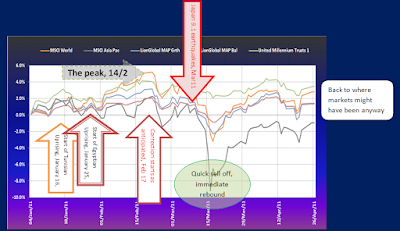Model Portfolio Update, May 12, 2011
Today, I don't just want to show you how well our portfolios are faring, but - tell you about some of the strategic decisions that have contributed to their success.
The inception of most portfolios was in October 2009. The graph clearly demonstrates that portfolio valuations are well above benchmark funds and Asian indices. The only index that has fared 'better' is the MSCI World index, simply because the US and European indices rallied for much of the second half of 2010, while our portfolios were constrained by my conservative view at the time.
The inception of most portfolios was in October 2009. The graph clearly demonstrates that portfolio valuations are well above benchmark funds and Asian indices. The only index that has fared 'better' is the MSCI World index, simply because the US and European indices rallied for much of the second half of 2010, while our portfolios were constrained by my conservative view at the time.
 |
| portfolios in overview since inception in October 2009 |
The argument was that while portfolios managed to avoid the sharp correction in April, we also re-engaged in equities as early as mid May and stayed in till September, building up a big 'safety margin' and comfort zone vis-a-vis benchmarks and global equities. I therefore did not see the need to 'push our luck', by leaving allocations unchanged beyond September, when it seemed inconceivable for markets to rally further. - But I misjudged the impact of QE2 on global stock markets. The resulting 8-week outperformance was restricted to developed markets. From the chart you can also see that since the beginning of 2011, Asian indices show only a negative performance, despite the frequent ups and downs as a result of increasing volatility I had warned about long before.
It should therefore not surprise that during the first six weeks of 2011. we continued to keep a lower equity exposure than under 'normal' investment conditions. The real turnaround was only due for the second half of February 2011. The effort to switch in decisively brought portfolio valuations to their highest level since inception.
| switching dates |
You may wish to check the dates of the switches to see just how close we came to actual market/fund price tops for exits - and bottoms for entries, especially since November last year.
Principles of Engagement
Here are some of the main concepts and deciding factors we follow in our management of portfolios since inception:
- Risk Goes Before Reward. In order to create returns we cannot AVOID risk. Indeed, we must actively engage and manage it.
- Understanding - and correctly assessing - the risk within markets is key: A simple, fundamentally-based forecast is NOT ENOUGH, especially if it attempts to portray past investment conditions as a linear extension into the future.
- The risk we take must reward appropriately. The risk we take must bring adequate return, .i.e. as the risk - reward ratio deteriorates we will be switching to safety. We endeavour to maintain a 'healthy' relationship between risk and reward.
- Trends are important for the purpose of obtaining performance and reducing volatility in the portfolio. Only during the period in January and early February did the normal trends (=funds investing in our prioritised trends) underperform the general market. The reason for that was simple: we were focusing on trends in Asia, and emerging markets. These markets were shunned by foreign investors during that brief period, which saw moneys flowing out of emerging markets and into developed markets. This sentiment did not last long. By mid-March 2011, punters returned in droves.
A New Portfolio
Since January 2011, we have introduced another portfolio, PORT E, which unlike the first four, is geared toward smaller portfolios with limited switching action, i.e. may be not more than 3-4 a year. Clearly allocation into such a portfolio has to be build up quite differently, using more - so called - uncorrelated asset classes to mitigate market turbulances. But funds will still only be chosen from the Singapore retail space - so anyone should be able to follow. I cannot promise that it will deliver as smooth a return as the others, - but this is one for the more long-term oriented investment approach. Still, the same rules apply as for all: if there is a chance for more than -5% correction, - we will probably switch to safety. But with the addition of less volatile funds and those with lower correlation to equity, we hope to make the level of switching activity more conducive for the busy - but less worried investor.
We shall see how it turns out, soon enough.




Comments